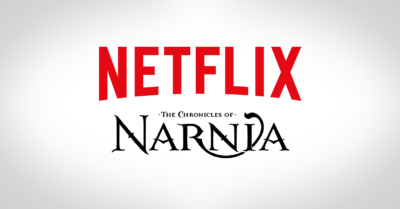Wheaton College Conference: Day 2
Day Two from Wheaton College Conference
by NarniaWebber Lady Éowyn
A much awaited part of the 50th annual writing and literature conference at Wheaton College was the “movie clips” presentation, slated for 3:45 on Friday. We were worried we would be late: we ran up to the Coray Alumni Gym after taking pictures of ourselves with the real wardrobe (complete with furs hanging inside!) at the Wade Center.
We weren’t late. However, thank goodness for technical difficulties! The two slide-down white screens on either side of the stage were blipping messages, tecchies at the back kept having to ask for more time. So we had a wonderful talk about the movie given by Chris Mitchell, director of the Wade Center. First off, it was announced that Ernie Malik would have attended the conference to speak to us at this point, before the movie clips, but he was on location in France to film a movie starring Russell Crowe!
A strategic unfolding of the grand Narnia poster, to “oohs” and “aahs,” was followed up by an audience member shouting, “Twenty five dollars!” Doctor Mitchell laughed. “Do I hear fifty?”
He explained his connection with the movie first: Cary Granat, CEO of Walden Media, contacted the Wade Center two or three years ago. At this point they were still deciding on the filming location and Disney had not come into the picture, so I’m leaning towards three years or more.
Later he was in contact with Ernie Malik. Mitchell said he had been allowed to see an early version of the screenplay at some point.
Note that anything following is Mitchell’s opinion from the early screenplay he read. If something sounds negative – please do not panic. Read it thoroughly and form your own impressions of what is opinion and what is not in Mitchell’s pros and cons. Note also that the negative elements mentioned were the only specific things I can talk about. The wonderful things – mentioning how great it’s going to be, was harder to focus in on in small elements.
He highlighted some of the things he was disappointed with – he mentioned that there would be several things that Narnia fans would wish was in the movie, that they may be disappointed and ask, “How can this be The Lion the Witch and the Wardrobe without such-and-such?”.
Much of what he said NarniaWeb enthusiasts have, of course, heard – the wolves chasing the children across the frozen river, the ice breaking up, and the extension of Tumnus’ character.
He mentioned a conversation with Bob Phillips who worked with Phillip Anschutz, the owner of Walden Media, in which Mitchell pointed out an issue he had with the script. Apparently, when Lucy gets up in the middle of the night worried because the others don’t believe her, she begins to doubt herself and walks down the hallway to take another peek in the Wardrobe. At this point we hear a toilet flushing and Edmund’s head pokes out of a doorway, watching and then following her.
This was something Mitchell didn’t like, as it was somewhat of a pivotal point for the children to be heading to the wardrobe, to have a comic toilet flush added. So, he added, that would be his claim to fame if there is no toilet flush!
Unfortunately, he said that most of the scene with the beavers (at least in this early version of the screenplay he saw – bear this in mind!) explaining to the children exactly who Aslan was, was shortened, putting more emphasis on the children, and that the beavers had an ongoing comedic banter that seemed distractive (here he seemed to be picking his words carefully).
He also said that the Thaw seemed to be, by his reading, was less attributed to Aslan, it seemed that he arrived after it, and that it was caused by the children.
But overall he was very fair in his weighing of the movie. He mentioned how much Adamson was grounded, and that he loved the books. He said that the narrative line followed the books very closely.
He said that the screenplay was wonderful. The scenes with Tumnus and Lucy were touching, and at the point of the death and resurrection of Aslan, at which point he said the “script sparkled.”
After much clapping, the projectors finally worked! The teaser trailer beginning was a bit disillusioning, as we were expecting movie clips. But it was wonderful to see it on a large screen with a lovely sound system!
Next was Chapter III: Locations (the chapters were played rather out of order).
Then came Chapter I, at which point we were settling back for what we had already seen dozens of times. Then we saw completely new shots filtered into our beloved Chapter I: Richard Taylor fingering chain mail, some wonderful shots of a centaur being fitted up, more early computer renditions of centaurs running.
Then was Skandar Keynes, in a room like the one in which the “centaur” steps out of his horse “cart.” He appears to be in normal clothes, but he’s swinging Peter’s sword. In the same room, Anna Popplewell was testing her bow. Her hair was pulled back, and she wearing a white blouse under her belt and quiver from Father Christmas.
Those were the only recognizable differences.
Next was Chapter II, Director, which was completely reconstructed. No memorable new shots, but many were longer than they are in the internet clip, and the syntax of the entire clip was rearranged. New music was added to accommodate this.
Then we saw the Chapter IV, which was regrettably the last clip (many of us were expecting actual movie excerpts). The order was arranged differently here as well. An interesting shot was what was obviously the lower half of Rumblebuffin being sculpted, still white and actually headless! We also got a brief shot of Aslan’s camp.
Near the end he said that the films “will rip people.”
THE WAY INTO NARNIA
Day Two from Wheaton College Conference
by NarniaWebber Lysander
“Want to find the way into Narnia?” conference speaker Peter Shakel asked invitingly. There were no head nods, but certainly everyone’s attentions were fixed. “Open the book The Lion, the Witch, and the Wardrobe-not The Magician’s Nephew,” he added hastily, “and start reading the first paragraph.”
I could already hear the publication order fans applauding.
Yet while Shakel affirmed that one has to let the books “speak for themselves,” the Chronicles-or, for that matter, any piece of literature-must be read with a few principles in mind:
“The Chronicles,” Shakel concluded, “are not Sunday School lessons looking for a teacher.”
After a chapel service by Rev. Michael Ward, a speaker of the day before, came David Downing to speak about “source criticism.” In contrast to Shakel’s talk, this did plunge deeper into the books, but not so deep that the points will lessen my appreciation of the books.
Why consider the sources of the Chronicles anyway? you might ask. Dr. Downing gave four reasons:
Downing then proceeded to outline the three basic steps of good source criticism-provenance, parallels, and perception-and apply them to several supposed sources, both lived and literary, for Lewis’ Chronicles.
The “movie preview” I geared you all up for was rather lame, honestly. Not only were there technical difficulties, but all the footage consisted of was the trailer and four of the behind the scenes featurettes previously released on the web. Lady Eowyn, of course, did pick up a few additional shots, but I would say, personally, that they were rather trivial.
Now comes the good part.
Chris Mitchell, manager of the on-campus Wade Center came up to introduce the clips, revealing that he read an unfinished version of the script and was open to questions.
According to Mitchell, while the movie will follow a discernable plot line, and stay, at the core, true to Lewis’ books, we must all be prepared to have some favorite scenes and moments cut out. The death and resurrection of Aslan however, will “sparkle” if the script Mitchell read and the beautiful visuals we have been seeing over the past few months are mixed well. If so, “there will not be a dry eye in the place,” he stated.
The change which bothered Mitchell most, both plot-wise and spiritually, was the nature of the thaw, not this toilet flush that has been creating such a stir around the boards. In the books, of course, Aslan alone brings spring with him into Narnia. In the movie, on the other hand, the children’s coming causes it to a greater extent.
The way in which the children enter Narnia seems also to have been somewhat changed. Many have commented that the hide-and-seek game looks as if it will take place during Lucy’s discovery of Narnia, and this may well be, for it seems as if the second entrance will take place at night. Lucy, torn apart by doubt now if the magical country in the wardrobe is actually true, rises from her bed and goes to take just one more peek. Edmund follows her with the controversial toilet flush.
I asked Mitchell two of the questions that have been plaguing these boards: (1) whether the Witch’s attempt on Edmund’s life and his subsequent rescue was to take place within the Witch’s ice castle, and (2) whether Tumnus was going to have a larger part. To the first, he reported that in the version he read, the rescue scene was not set within the Witch’s castle. To the second, he replied that Tumnus did seem to have a larger part in the script and that his scenes with Lucy promised to be the movie’s most endearing. However, when I reframed the question (in private) to indicate the rumors that Tumnus’ escape might be shown onscreen, and that Edmund might see him in a pre-petrified state, he could not remember.
On the other hand, the conference was not about the movie, it was about Lewis, and the evening’s dramatic performance by Tom Key brought this back into focus.
Key starred as the Chronicle-er himself in the one-man play C. S. Lewis on Stage. Some of the lines in this play were original, but the bulk of the script borrowed from Lewis’ own works, including Surprised by Joy, The Screwtape Letters, and The Great Divorce. Most of this was funny, but the ending was so sad and moving I had tears in my eyes. But then again, I always have tears in my eyes.
The one, true way into Narnia will always be the books themselves, but the Wheaton conference did not lessen the magic for me-in fact, overall, I would say it heightened the Chronicles‘ charm by reminding us of its author, depth, and simplicity.





